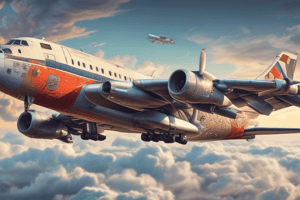Podcast
Questions and Answers
Based on the document provided, what can be inferred about its structure?
Based on the document provided, what can be inferred about its structure?
- It is a complete, standalone document.
- It is a part of a larger document. (correct)
- It includes an index at the end.
- It contains a table of contents.
Flashcards
Amt 223
Amt 223
A specific reference or identifier, possibly denoting a course or segment.
Part 1
Part 1
The initial segment of a larger document or course.
Content Outline
Content Outline
A general structure or framework for what is covered.
Segmentation
Segmentation
Signup and view all the flashcards
Course Structure
Course Structure
Signup and view all the flashcards
Study Notes
Introduction
- Aircraft fly at high altitudes primarily for economic reasons, but humans can't survive in this environment without support systems.
- At 40,000 feet, temperatures are around -56°C, air pressure is low, and there's insufficient oxygen.
- Crew and passengers need protection from freezing and death.
Air Conditioning System
- The system maintains the correct cabin pressure to support life.
- It ventilates the cabin to keep a comfortable temperature range.
- Aircraft systems need cooling and heating to prevent overheating during hot days on the ground.
Air Conditioning Functions
- The system must regulate 5 key factors: freshness, cleanliness, temperature, humidity, and pressure.
- Regulations stipulate a minimum amount of fresh air per passenger (0.283 m³/min and 0.35kg/min at sea level).
- The air needs to be filtered and free of hazardous gases, which is achieved through ozone converters and air filters.
- Comfortable temperatures for passengers and crew range between 18°C and 30°C.
- Humidity levels must regulate to avoid condensation.
Pressurization and Zones
- Aircraft cabins have pressurized and unpressurized areas.
- Pressurized sections include the cockpit, passenger compartment, and some cargo compartments.
- Air conditioning systems regulate cabin pressure to match ground level conditions. This is necessary for passenger comfort and to safely operate the equipment.
- Unpressurized parts include landing gear bays, the radome, and the tail cone.
- Specific zones for different compartments on wide-body aircraft are defined (e.g. zones A-E and U/D on B747-400).
- The number of zones depends on the aircraft's size, for example, an A320 has 3.
System Layout
- Air conditioning systems draw air from the pneumatic system.
- Air is cooled using multiple, identical packs.
- The outflow valve regulates airplane cabin pressure.
- Hot air is mixed with cooled air for a desired temperature.
- Regulated air is distributed through compartments.
Exercises
- The air conditioning system begins at the pack valve.
- Normal cruising altitude for civil aircraft is regulated to a maximum of 14,000 feet.
Studying That Suits You
Use AI to generate personalized quizzes and flashcards to suit your learning preferences.



